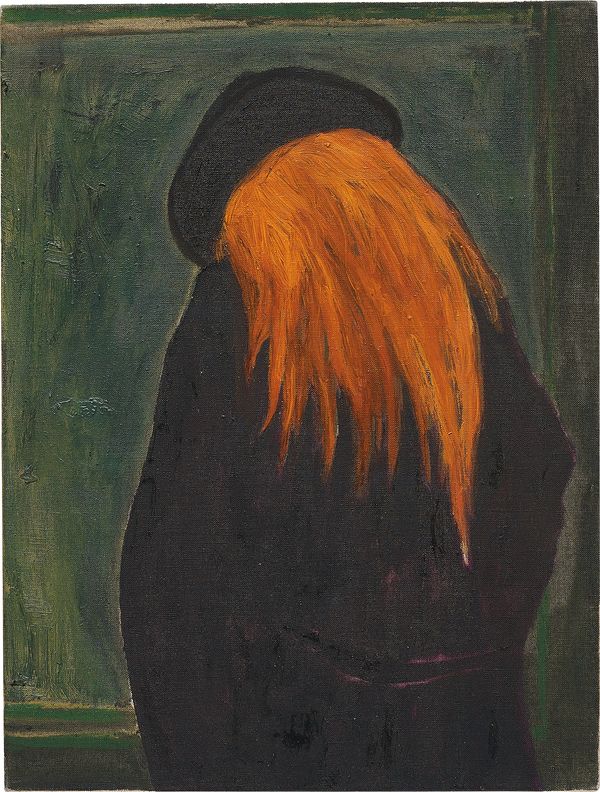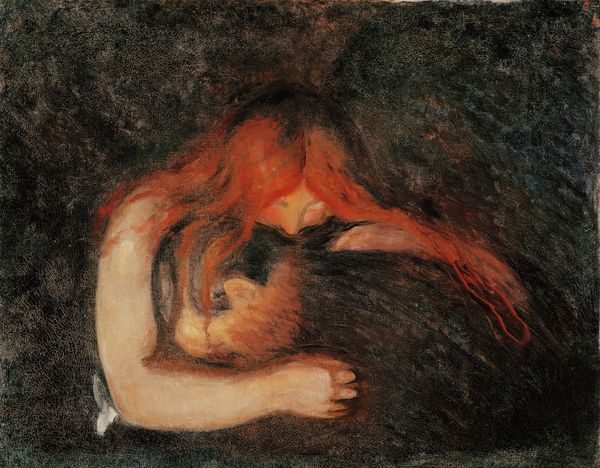Peter Doig House of Pictures, 2002-2003
To experience Peter Doig’s House of Pictures, 2002-2003, is to engage in an exhilarating game of push and pull. A dazzling flame of orange hair arrests our attention, yet the figure to whom it belongs’ backward stance rebukes our advances; manifestly in view but physically inaccessible. The intimacy of its scale invites familiarity, but this too is a double-edged sword, as the severe cropping creates an unsettling sense of claustrophobia and entrapment, all the while excluding the viewer from anchoring it to any sense of time and place; but for the blazing swathe of orange, the figure seems almost intangible.
It is a hallmark of Doig’s oeuvre to conceal, obscure or otherwise remove his figures just beyond the viewer’s reach. Following in the tradition of Edward Hopper’s late-night diners and Cindy Sherman’s Untitled Film Stills, Doig toys with our human compulsion to impose narrative. The saturnine protagonist of House of Pictures refuses to give us any clues, leaving them an empty canvas onto which the viewer’s imagination can project their memories, dreams, and fantasies. Following the same bloodline, Doig’s painting has an undeniably cinematic presence and magically instills a sense of nostalgia for a past the viewer has not even necessarily experienced themselves. As one scholar observes: "As a matter of course, Doig’s work displays a resolute, unwavering faith in the medium of painting. Free of compulsions to provide justifications, of pressures to engage in argumentation, this attitude expresses a contemporary sensibility, a consciousness that inscribes the past—and implicitly, nostalgia and sentiment as well—into the image as a perpetually renewed process" (Peter Doig: No Foreign Lands, exh. cat., Scottish National Gallery, Edinburgh).
Edvard Munch Vampire, 1893-1894, oil on canvas, Munchmuseet, Oslo. Image: De Agostini Picture Library / Bridgeman Images
The work’s formal economy means that it occupies a liminal space between figuration and abstraction: reality as filtered through the prism of Doig’s inimitable imagination. Indeed, this is an enchanting example of the artist’s class of magical realism. The insistence on a reference point from the tangible world has been described by Doig as a desire to be "hinged in reality, hinged in a believeableness" (Peter Doig, cited in Robert Enright, 'The Eye of the Painting: An Interview with Peter Doig'). It is this effortless assimilation of the two realms of abstraction and figuration into an enchanting dreamscape that singles Doig out as a leading figure in contemporary art’s "return to painting." Doig’s distinctive visual grammar interweaves personal recollections and found imagery with references to art history, as in House of Pictures. The artist amasses his sources from film, photography or from his own lived experience, yet these collages of influence can only truly be actualized through paint on canvas. The figure in House of Pictures is at once uniquely biographical to Doig but also a familiar leitmotif in art history: the shock of red hair has previously adorned the subjects of Gustav Klimt, Edvard Munch, the Pre-Raphaelites and Sandro Botticelli.
In Chicago, I saw the painting by Daumier, 'L’amateur d’estampes,' of a man looking at prints. The 'House of Pictures' became my version. — Peter Doig
Honoré Daumier L'amateur d'estampes, 1852–1868, oil on cradled panel, Art Institute of Chicago.
House of Pictures has a fascinating genesis, alongside its larger, sister piece from the same year. Doig was first inspired to make the work in response to an encounter with a 19th-century picture gallery named "Haus der Bild" (House of Pictures) he encountered during a summer sojourn in the Austrian capital. Initially only painting the façade, it was not until two years later that he found the lead character for the work, chanced upon outside a restaurant in Vancouver. This person was "a guy getting into a minivan; he had his hands in his pockets, looking for his keys, and he was dressed all in black leather like Johnny Cash. He was actually native Indian. I never saw his face but he had this incredible mane of black hair and this black hat, and he had on these extreme cowboy boots. It was the body position that I liked. But in my painting I wanted the figure to look European, so I made his hair red instead. I wanted him to be like a figure from a Fassbinder film" (Peter Doig, cited in Robert Enright, 'The Eye of the Painting: An Interview with Peter Doig').
It is this unique patience for, and confidence in finding the perfect missing pieces for his works, which he then unites and reworks from their disparate histories into a single whole which singles Doig out as one of the foremost imaginations of his generation.


